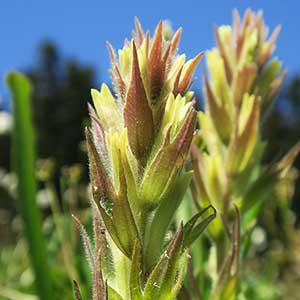Castilleja angustifolia
Castilleja cryptantha
narrow-leaf paintbrush, northwestern Indian paintbrush, northwestern paintbrush, violet desert paintbrush
Mt. Rainier or obscure paintbrush, obscure Indian paintbrush, obscure paintbrush
few to many, ascending to erect, branched, especially near base, sometimes unbranched, hairs sparse to dense, spreading to retrorse, long, sometimes short, soft to stiff, usually mixed with short-glandular ones, sometimes viscid.
few to several, erect or ascending, unbranched, hairs spreading, long, soft, eglandular, mixed with short stipitate-glandular ones.
brown or purplish, sometimes green, linear to lanceolate or broadly lanceolate, 1.2–7(–7.5) cm, not fleshy, margins plane, sometimes ± wavy, involute or flat, (0–)3–5-lobed, rarely with secondary lobes, apex acuminate to rounded;
lobes spreading, oblong or lanceolate to linear-lanceolate, apex acute to rounded.
green, often with brown or purple veins, narrowly to broadly lanceolate, 1.5–4 cm, not fleshy, margins plane, ± involute, 0–3-lobed, apex acute to acuminate;
lobes spreading-ascending, narrowly lanceolate, apex acute to ± obtuse.
2.5–20 × 1.5–5 cm;
bracts proximally greenish or dull purplish, distally pink, magenta, pink-purple, reddish pink, pale yellow, pale yellow-orange, pale orange, or white, rarely reddish or orange-red, lanceolate to oblong, 3–5(–9)-lobed, sometimes with secondary lobes;
lobes spreading or ascending, oblanceolate or linear, proximal lobes often much longer than distal, proximal lobes arising below or a little above mid length, apex acute to rounded.
(2.5–)3–6 × 1–2 cm; green to dull brown or dull reddish purple throughout, or proximally green to dull brown or dull reddish purple, distally yellow on apices, broadly lanceolate to ovate, (0–)3-lobed;
lobes ascending, narrowly lanceolate, long or short, arising near mid length, apex acute or acuminate.
straight, 18–27(–32) mm;
tube 8–17 mm;
beak usually long-exserted, adaxially green or pink, 8–15 mm;
abaxial lip deep green, reduced, inconspicuous, 1–2.5 mm, 5–20% as long as beak;
teeth incurved to ascending, deep green, 0.5–1.5 mm.
straight, 14–16 mm;
tube 11–14 mm;
whole corolla included within calyx;
beak adaxially pale yellow, 1–2 mm;
abaxial lip deep green, slightly inflated, 4–5 mm, 67% as long as beak;
teeth ascending, pale, 1.5–2 mm.
proximally green, yellow, brown, or purple, lobes colored as bract lobes, sometimes with a yellow band between proximal and distal parts, 13–25(–28) mm;
abaxial clefts 3–8 mm, adaxial 5–9(–12) mm, clefts 30–50% of calyx length, deeper than laterals, lateral (1–)1.5–4(–5) mm, 10–25% of calyx length;
lobes lanceolate to oblong, abaxials wider than adaxials, apex acute to rounded.
proximally green or pale with green veins, lobes yellow, sometimes becoming deep red with age, 12–15 mm;
abaxial and adaxial clefts 3–7 mm, 25–50% of calyx length, deeper than laterals, lateral 1–3(–4) mm, 8–20% of calyx length;
lobes triangular, adaxial segments longer than abaxials, apex acute or obtuse.
= 24.
Castilleja angustifolia
Castilleja cryptantha
Varieties 3 (3 in the flora).
Much confusion exists concerning Castilleja angustifolia and the closely related C. chromosa. Sometimes C. chromosa is treated as a variety of C. angustifolia, using the name C. angustifolia var. dubia. The latter name is used here to represent a different assemblage of plants, not including C. chromosa. At other times, C. chromosa is synonymized completely under C. angustifolia. However, the two species are in most cases easily separable, and where they are sympatric there is little evidence of intergradation. Both C. angustifolia var. dubia and C. chromosa are accepted here. See additional comments under 3b. C. angustifolia var. dubia and 15. C. chromosa.
(Discussion copyrighted by Flora of North America; reprinted with permission.)
Castilleja cryptantha is endemic to the vicinity of Mt. Rainier in the Cascade Range, with most populations found within Mt. Rainier National Park. Unlike most species of Castilleja, it is apparently self-pollinating (W. J. Duffield 1972); the small flowers are entirely enclosed within the yellowish calyces, which tend to grow deep reddish as they age. The purplish brown bracts are also unusual in the genus.
(Discussion copyrighted by Flora of North America; reprinted with permission.)
1. Bracts distally usually pink to pink-purple; s Idaho, sw Montana, se Oregon, nw Wyoming. | var. angustifolia |
1. Bracts distally yellow, yellow-orange, pale orange, white, pink, reddish pink, or magenta; se Idaho, e Nevada, sw South Dakota, w Utah, ec Wyoming. | → 2 |
2. Bracts distally usually yellow to pale orange or white; ec Wyoming, adjacent sw South Dakota. | var. dubia |
2. Bracts distally usually yellow, yellow-orange, white, pink, or reddish pink; se Idaho, e Nevada, w Utah. | var. flavescens |



